With our cutting-edge environmental technologies that allow both for reducing environmental risks and for economic efficiency, our company is actively responding to social problems such as disposal of wastes and new recycling needs. In October in Okayama we started detoxification of trace amounts of PCB wastes using Japan's first continuous heating furnace. We are also committed to R & D for practical use of our recycling technologies in response to increasing demands for solar panels, rare earth magnets and lithium ion cells.
We are also contributing to building a resource-recycling society by integrating three main business activities of waste disposal, metal recycling and soil remediation in Asian countries. Recently the amount of waste has been drastically increasing along with rapid economic growth in Asia. We are aggressively deploying our business services there. We officially announced operation of a recovering and smelting plant of precious metals in Singapore this April. We will further promote resource-recycling across the borders, considering the whole Asia, by combining our bases both in and out of Japan in a seamless manner.
Our ultimate goal is to be recognized as the top company in Asia leading in the field of environmental improvement. For that purpose, we will further improve our resource-recycling technologies and foster human resources who can think and resolve environmental problems on a global basis.

ECO-SYSTEM Sanyo
Address: 1125 Kichigahara, Misaki-cho, Kume-gun, Okayama Prefecture 708-1523
Employees: 101 (as of the end of March 2013)
Top Class Incinerating Plant in Western Japan
ECO-SYSTEM Sanyo (ESY) was established as an intermediate treatment plant of industrial wastes in 1977 in the mining town of Sakuhara, which was said to be the largest sulfide iron ore mine in the Orient. The strength of this company is the ability to handle wastes that other general waste disposal plants cannot treat. ESY uses advanced technologies cultivated in mining and smelting business and know-how inherited and used for more than 30 years from its predecessors, Okayama Koyu and Dowa Kogyo Okayama Clean Works.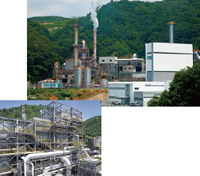
ESY has a three-series incineration plant and have the largest capacity in Western part of Japan of approximately 200,000 tons per year. Not only our advanced technologies but also a high degree of trust gained from local communities through 75 years of managing Sakuhara Mine greatly contributed to our development and implementation of the incineration plant for trace amounts of PCB. We were recognized as an "excellent" waste disposal company by Okayama Prefecture in February 2012. We handle waste-disposal in a safe and proper manner in response to varied needs of our customer companies.
Trace amount of PCB Incineration Plant Started Operation
PCB (Polychlorinated biphenyl) has been widely used for electric appliances including transformers and capacitors as it had excellent characteristics such as insulation and incombustibility. However manufacturing of PCB ceased in 1975 due to its toxicity. Final disposal of PCB has not been completed, as PCB disposal plants are not easily constructed and many companies still store appliances containing PCB as they are. To resolve this problem, the PCB Special Measure Law was enacted. Companies that store PCB are now required to dispose all PCB by July 2016.
ESY started operation of the continuous incineration plant for trace amount of PCB (content: a few mg /kg - some 10 mg/kg) in October 2011, responding to the need of PCB disposal. An appliance containing trace amount of PCB is put in an enclosure, which is then placed into the furnace and heated at 850邃・for 4 hours or more. Evaporated PCB is, then, incinerated under high temperature of 1.100邃・for 2 seconds or more to be detoxified. This continuous tunnel type furnace has a very high disposal capacity of 48 tons/day and is contributing to the disposal of approximately 1.2 million (estimate) appliances containing lower-levels of PCB in Japan.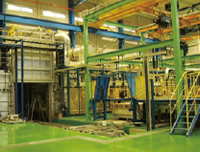
Incinerated electric appliances are disassembled and separated for recycling as they contain a large amount of metals including iron and copper. The plant is eco-friendly, as solar panels are installed on the roof of the new plant, generating part of electricity for operation of the plant.
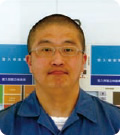
We started the construction project in April 2009, aimed at starting operation in October 2011. In addition to the tight time schedule of construction, the Great East Japan Earthquake affected our ability to procure construction materials temporarily. Despite of the anxiety about the possible delay of completion of construction, we managed to start operation as planed thanks to the efforts of all relevant parties. This project is the first plant approved by the prefectural governor in Japan complying with the Waste Management Law and the plant can handle a wide range of trace amount of PCB wastes. Both manufacturing department and sales department in cooperation endeavor to strengthen the waste disposal system for lower-levels PCB.
Takeshi Tayama
the Second Operation Section
(ECO-SYSTEM Akita PJ leader since April 2012)
Our Effort to Disclosure of Information
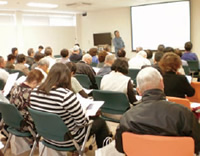 ESY believes to gain trust from local people is essential for continuing our business. ESY strives to operate the plant, considering the quality of exhaust and odor, and to disclose information in an easy to understand manner. We invite local people to visit our facilities every year. We explain them the number of complaints on odor we received and the amount of chemical substances in the exhaust such as dioxin. We strictly monitor for odor in the neighboring area every day. We have also set up a telephone line dedicated to providing information about odors and established a system in place to quickly respond to complaints on odor from local people.
ESY believes to gain trust from local people is essential for continuing our business. ESY strives to operate the plant, considering the quality of exhaust and odor, and to disclose information in an easy to understand manner. We invite local people to visit our facilities every year. We explain them the number of complaints on odor we received and the amount of chemical substances in the exhaust such as dioxin. We strictly monitor for odor in the neighboring area every day. We have also set up a telephone line dedicated to providing information about odors and established a system in place to quickly respond to complaints on odor from local people.
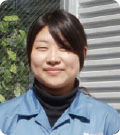
The new furnace started in 2011. However, in the meeting to explain to local residents I faced the fact this industrial waste disposal plant is a nuisance for them. As we were not able to apply for construction of the new furnace without consent from them, we endeavored to respond to their concerns in a sincere manner to obtain consent from them. Maintaining favorable relationship with local community is requisite to continue business. We will continue to devise ways to make the local community feel reassured. We want to relieve their reservations by providing residents with clear and open disclosure of information such as analyzed data of exhausts at local meetings.
Kanako Mori
Management Section
(DOWA ECO-SYSTEM Geotech, Operation Department since April 2012)
 Receiving Internship of Junior High School Students
Receiving Internship of Junior High School Students
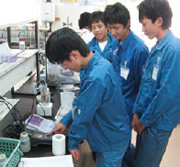
As part of internship for local Sakuhara Junior High School, four students joined in our workplace for four days. We started the internship in 2006 and so far we have received 17 students for six internship events. They experienced analytical activities we handle in our daily operation to gain understanding of our work by providing on the job training both inside and outside. They were not familiar with waste disposal plant, but after the internship, we received comments from them that the internship was a very valuable experience and they would think about it as a career.



